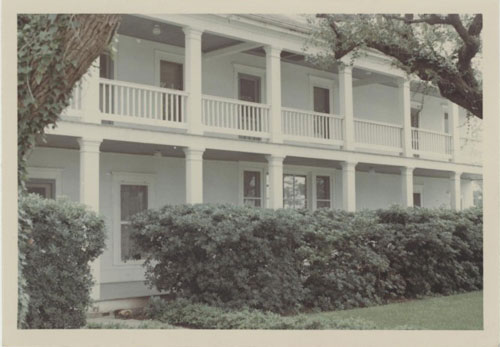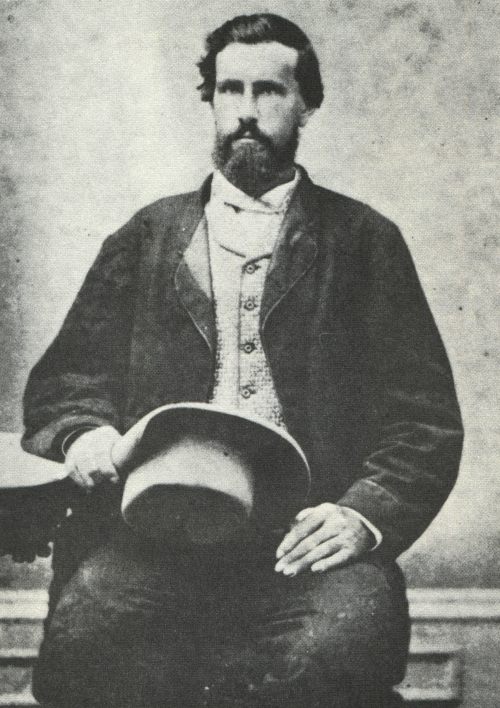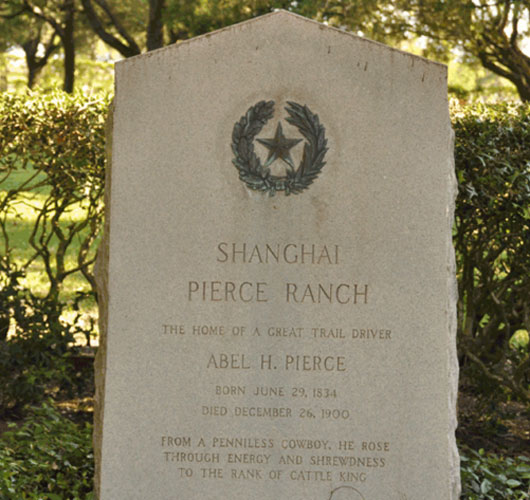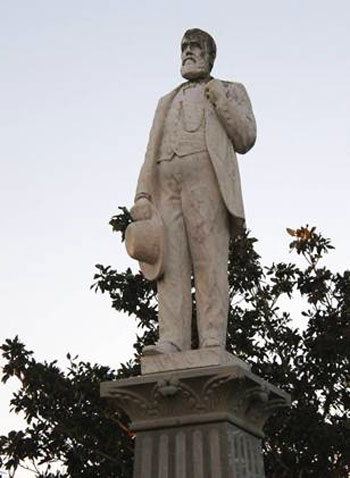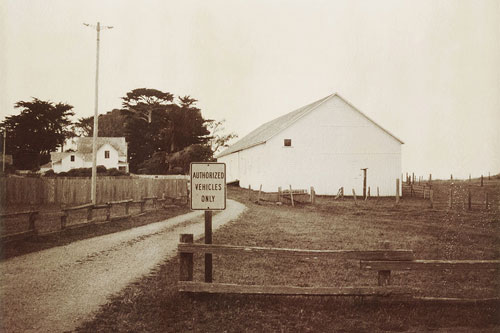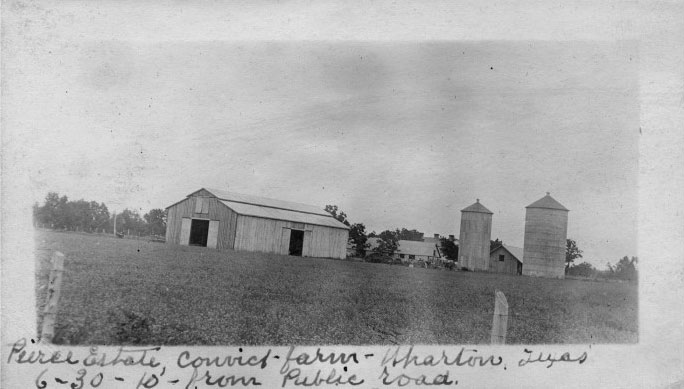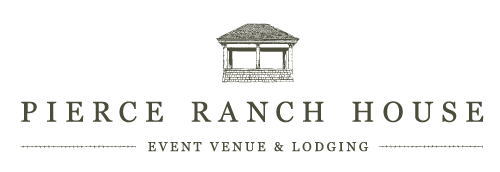The Pierce Ranch House is the headquarters residence of a 32,000 acre working agribusiness operation. The business is diversified, but all departments depend on the natural resources of land and water. The ranch raises F-1 Braford cattle. There is farming for rice, corn, grain sorghum, cotton, and soybeans. The ranch cultivates live oak trees and native prairie seed. There are currently plans underway to explore eco services and regenerative energy. And, of course, our newest venture, hospitality.
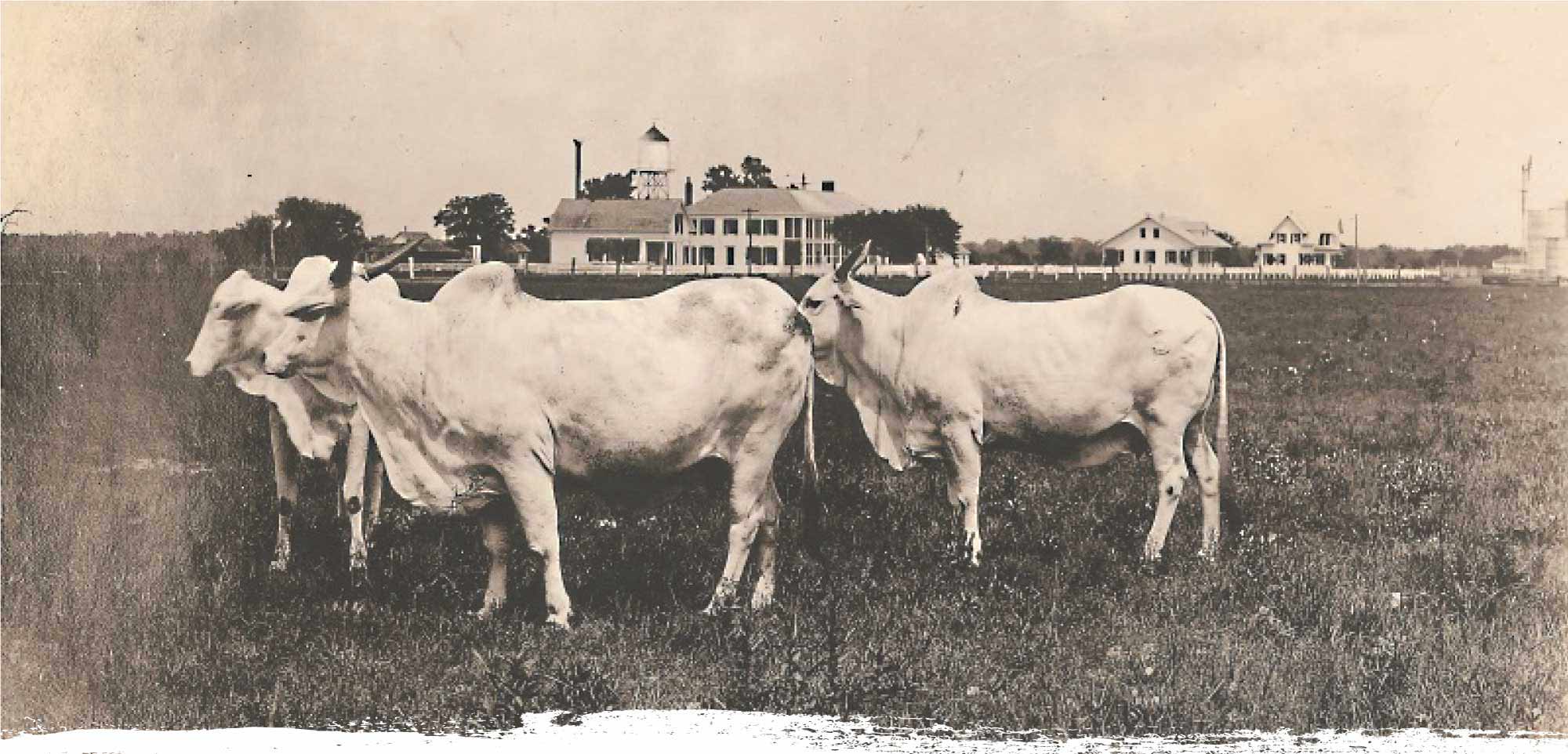
OUR HISTORY
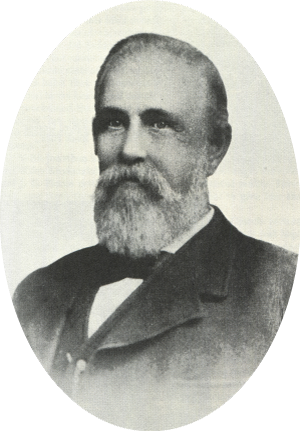
Founded in the early 1800s, this magnificent place would not exist without the ambition and strength of character of its founder, Abel Head “Shanghai” Pierce, one of the most colorful cattlemen in early Texas history.
EARLY LIFE
Abel H. Pierce was born in 1834 in Little Compton, Rhode Island, one of two boys and seven girls in a family of New England Puritans. By the age of 19, Abel had sprouted to 6’5”, and had swallowed “too many doses of sanctimony.” He decided to make his fortune as far away from home as he could imagine, so he stowed away on a boat bound for Cuba. The lanky youth was discovered and deposited on the shore of the Gulf Coast of Texas in a tiny town called Indianola. Pierce began to work as a hand on local ranches, breaking horses, hauling loads, splitting lumber, and generally doing all the grunt work that needed to be done. He soon proved too clever and ambitious for his bosses, however, and began dealing with them to take small plots of land and cattle in lieu of pay. At a certain point, Pierce invited his brother Jonathan Pierce to join him on the Texas frontier, and the two established their first ranch, the famous Rancho Grande on the Tres Palacios near Blessing. He married Fannie Lacy, daughter of William Demetris Lacy who was a signer of the Texas Declaration of Independence and second judge of the Municipality of Colorado. They had two children; a daughter, Mary Francis, and a son who died at the age of four months. Fannie died shortly after in 1871.
THE CATTLE EMPIRE
After the death of his wife in 1871, Pierce sold out and moved to Kansas City. One legend has it that he was a participant in the gunfight at the OK Corral, although Shanghai was notoriously crafty for avoiding direct confrontation when it came to firearms. After eighteen months, he returned to Texas and started buying up land in Wharton and Matagorda counties to establish what would become The Pierce Ranch. He formed the Pierce-Sullivan Pasture Company and sent thousands of cattle to the markets in the north. The name “Shanghai” Pierce became synonymous with cattle in Texas, Oklahoma, Missouri and Kansas, as he spearheaded large cattle drives through these states. He was constantly trying to improve the quality of his herd, known as “mossyhorns,” and had a keen understanding of the climactic constraints posed by both his home pasture and the places he was sending the cattle. A.H. Pierce displayed many characteristics shared by the tamers of the Texas prairie. He was bold, danced on both sides of the law, and made many admirers and enemies alike. His nickname derives from the figure he cut when he would strut around, the rowels on his spurs spinning, like a “shanghai rooster.” At the peak of his holdings, Pierce controlled approximately 500,000 acres, extending down the Colorado River from Columbus all the way to the coast at Matagorda. His acreage was second only to Captain Richard King of the King Ranch. He called himself “Webster on Cattle” for his extensive knowledge of this animal, its habits, and commercial potential for beef production.
LATER LIFE & LEGACY
“Shanghai” Pierce tried his hand at other ventures such as banking and railroad ownership, but his real interest was always cattle. Towards the end of his life, he planned to experiment with a new breed resistant to the heat, humidity, and ticks so prevalent in the Gulf Coast area. He toured Europe and returned convinced that Brahman cattle were the most likely to be immune. Though these cattle only lived in India, and were sacred to the Hindu religion, he was determined to bring them to his ranch. Pierce died on December 26,1900, before the realization of this dream. However, in 1906 Abel Pierce Borden, nephew of Shanghai and executor of the estate, was sent to India to import the Brahman cattle. A total of 51 head reached the United States and were placed under quarantine. After a special pardon by President Theodore Roosevelt, the cows cleared quarantine and headed to Texas. Today, the Brahman breed remains a vital part of the Pierce Ranch and continues to be the cornerstone of the majority of Texas breeding operations.
THE RANCH
At the rise of his cattle empire, Shanghai selected a sight on the Colorado near Wharton to establish his ranch headquarters. He built the fine two-story ranch house that we know today, as well as an office, blacksmith shop, barns, silos and several tenant houses. It was here that his empire truly flourished, and its 32,000 acres still serve as a working cattle ranch today. While Shanghai Pierce was focused mainly on cattle, his nephew felt that there was other potential to be gained from the land. So in the early 1900’s, Borden commissioned the construction of canals to cross the ranch and provide water to irrigated crops, mainly rice. The canals were powered by a pumping plant on the bank of the Colorado River, and the Pierce Ranch was granted the second private water right on that waterway. The pumping plant is still in operation today. In the 1930’s, oil was discovered on the ranch and Perry R. Bass and Texaco developed significant road infrastructure to service the many wells in operation. These roads penetrate the forest of the beautiful Columbia hardwood bottomland which flanks the river. The woods are therefore accessible to hunters, endurance horse riders, and nature lovers.
PIERCE, TEXAS
Later after the establishment of The Pierce Ranch, the New York, Texas and Mexican Railway established railway lines through Wharton county, providing easy transportation to market for the cattle. Pierce wanted the train to stop at his headquarters so he built the railroad station himself. It was called Pierce’s Station and also served the area as post office for many years. In 1894, with ambition to create a town around his railroad depot that would be the County Seat of Wharton, he had 160 acres surveyed to become the Pierce Townsite. He built and named the streets, laid out a public square, courthouse square, academy square, church, cemetery ground, and a grand gothic-style hotel to accommodate cattle buyers, traveling salesmen, and the like. The other citizens rejected the idea, for fear his ego and influence would grow larger. A visitor to Pierce’s Station once asked Shanghai, “Mr. Pierce, do you belong to that church?” Pierce replied, “No sir, that church belongs to me!” The town of Pierce did not develop as Shanghai hoped it would. The magnificent hotel saw few, if any, overnight guests. It was rented out to tenants for long terms and housed the office of Pierce Estate Oil & Gas from 1952 till 1980. It also served as residence and office for J. B. Ferguson as he organized the Superior Drilling Company, one of Wharton County’s early drilling operations. Over the years the building gradually deteriorated and was demolished in 1980. The New England styled widow’s walk and some of the railings have been restored on the original site and other railings and parts of the trim are on exhibit in the Wharton County Museum.
Abel H. Pierce was born in 1834 in Little Compton, Rhode Island, one of two boys and seven girls in a family of New England Puritans. By the age of 19, Abel had sprouted to 6’5”, and had swallowed “too many doses of sanctimony.” He decided to make his fortune as far away from home as he could imagine, so he stowed away on a boat bound for Cuba. The lanky youth was discovered and deposited on the shore of the Gulf Coast of Texas in a tiny town called Indianola. Pierce began to work as a hand on local ranches, breaking horses, hauling loads, splitting lumber, and generally doing all the grunt work that needed to be done. He soon proved too clever and ambitious for his bosses, however, and began dealing with them to take small plots of land and cattle in lieu of pay. At a certain point, Pierce invited his brother Jonathan Pierce to join him on the Texas frontier, and the two established their first ranch, the famous Rancho Grande on the Tres Palacios near Blessing. He married Fannie Lacy, daughter of William Demetris Lacy who was a signer of the Texas Declaration of Independence and second judge of the Municipality of Colorado. They had two children; a daughter, Mary Francis, and a son who died at the age of four months. Fannie died shortly after in 1871.
After the death of his wife in 1871, Pierce sold out and moved to Kansas City. One legend has it that he was a participant in the gunfight at the OK Corral. After eighteen months, he returned to Texas and started buying up land in Wharton and Matagorda counties to establish what would become The Pierce Ranch. He formed the Pierce-Sullivan Pasture Company and sent thousands of cattle to the markets in the north. The name “Shanghai” Pierce became synonymous with cattle in Texas, Oklahoma, Missouri and Kansas, as he spearheaded large cattle drives through these states. He was constantly trying to improve the quality of his herd, known as “mossyhorns,” and had a keen understanding of the climactic constraints posed by both his home pasture and the places he was sending the cattle. A.H. Pierce displayed many characteristics shared by the tamers of the Texas prairie. He was bold, danced on both sides of the law, and made many admirers and enemies alike. His nickname derives from the figure he cut when he would strut around, the rowels on his spurs spinning, like a “shanghai rooster.” He called himself “Webster on Cattle” for his extensive knowledge of this animal, its habits, and commercial potential for beef production.
At the rise of his cattle empire, Shanghai selected a sight on the Colorado near Wharton to establish his ranch headquarters. He built the fine two-story ranch house that we know today, as well as an office, blacksmith shop, barns, silos and several tenant houses. It was here that his empire truly flourished, and its 32,000 acres still serve as a working cattle ranch today. While Shanghai Pierce was focused mainly on cattle, his nephew felt that there was other potential to be gained from the land. So in the early 1900’s, Borden commissioned the construction of canals to cross the ranch and provide water to irrigated crops, mainly rice. The canals were powered by a pumping plant on the bank of the Colorado River, and the Pierce Ranch was granted the second private water right on that waterway. The pumping plant is still in operation today. In the 1930’s, oil was discovered on the ranch and Perry R. Bass and Texaco developed significant road infrastructure to service the many wells in operation. These roads penetrate the forest of the beautiful Columbia hardwood bottomland which flanks the river. The woods are therefore accessible to hunters, endurance horse riders, and nature lovers.
“Shanghai” Pierce tried his hand at other ventures such as banking and railroad ownership, but his real interest was always cattle. Towards the end of his life, he planned to experiment with a new breed resistant to the heat, humidity, and ticks so prevalent in the Gulf Coast area. He toured Europe and returned convinced that Brahman cattle were the most likely to be immune. Though these cattle only lived in India, and were sacred to the Hindu religion, he was determined to bring them to his ranch. Pierce died on December 26,1900, before the realization of this dream. However, in 1906 Abel Pierce Borden, nephew of Shanghai and executor of the estate, was sent to India to import the Brahman cattle. A total of 51 head reached the United States and were placed under quarantine. After a special pardon by President Theodore Roosevelt, the cows cleared quarantine and headed to Texas. Today, the Brahman breed remains a vital part of the Pierce Ranch and continues to be the cornerstone of the majority of Texas breeding operations.
After the establishment of The Pierce Ranch, the New York, Texas and Mexican Railway established railway lines through Wharton county, providing easy transportation to market for the cattle. Pierce wanted the train to stop at his headquarters so he built the railroad station himself. It was called Pierce’s Station and also served the area as post office for many years. In 1894, with ambition to create a town around his railroad depot that would be the County Seat of Wharton, he had 160 acres surveyed to become the Pierce Townsite. He built and named the streets, laid out a public square, courthouse square, academy square, church, cemetery ground, and a grand gothic-style hotel to accommodate cattle buyers, traveling salesmen, and the like. The other citizens rejected the idea, for fear his ego and influence would grow larger. A visitor to Pierce’s Station once asked Shanghai, “Mr. Pierce, do you belong to that church?” Pierce replied, “No sir, that church belongs to me!” The town of Pierce did not develop as Shanghai hoped it would. The magnificent hotel saw few, if any, overnight guests. It was rented out to tenants for long terms and housed the office of Pierce Estate Oil & Gas from 1952 till 1980. It also served as residence and office for J. B. Ferguson as he organized the Superior Drilling Company, one of Wharton County’s early drilling operations. Over the years the building gradually deteriorated and was demolished in 1980. The New England styled widow’s walk and some of the railings have been restored on the original site and other railings and parts of the trim are on exhibit in the Wharton County Museum.

